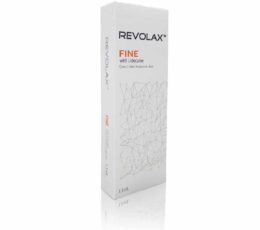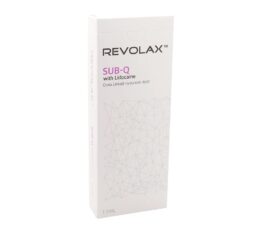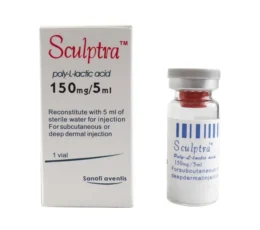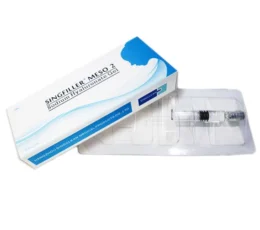Dermal fillers
BUY DERMAL FILLERS ONLINE
Dermal fillers are injectable substances used to restore volume, smooth wrinkles, and enhance facial contours. Composed primarily of hyaluronic acid or collagen, they provide immediate, natural-looking results. Popular in cosmetic procedures, dermal fillers rejuvenate the skin, offering a non-surgical solution to aging and aesthetic enhancements.
Showing 25–28 of 28 results
Revolax Fine 1 ml
Revolax Fine 1ml is a specialized dermal filler for superficial lines and delicate areas. With its advanced cross-linked hyaluronic acid formula, it effectively fills fine lines and enhances lip definition, providing subtle and natural-looking results. Trusted by professionals, it ensures safe and precise facial rejuvenation for a refreshed appearance.
Revolax Sub-Q 1ml
Revolax Sub-Q 1ml is a premium dermal filler formulated for deep tissue augmentation. With high viscosity and cross-linked hyaluronic acid, it restores volume and contours, delivering long-lasting results. Versatile and safe, it enhances facial features with natural-looking outcomes, providing patient satisfaction and minimal downtime.
Sculptra collagen stimulator filler
Sculptra collagen stimulator filler is an advanced injectable treatment. It stimulates collagen production, restoring volume and elasticity to the skin. Formulated with poly-L-lactic acid, it gradually improves skin texture, smoothing wrinkles and folds. Results are natural-looking and long-lasting, offering a youthful and rejuvenated appearance.
Singfiller Meso 2 Ml * 5 Syringes
Singfiller Meso 2ml * 5 offers comprehensive skin rejuvenation with its potent blend of vitamins, minerals, and hyaluronic acid. This mesotherapy solution hydrates, brightens, and smooths skin texture. Packaged in five syringes, it ensures multiple sessions for optimal results, addressing various skin concerns effectively.
Dermal Fillers
Dermal fillers are injectable substances used to restore lost volume, smooth out wrinkles, and enhance facial contours. They are a popular non-surgical solution for aging and aesthetic enhancements. Composed primarily of hyaluronic acid, calcium hydroxylapatite, poly-L-lactic acid, or polymethylmethacrylate, dermal fillers provide immediate, natural-looking results. Their versatility and effectiveness make them a staple in cosmetic dermatology.
Key Features and Benefits
1. Immediate Results
One of the most appealing aspects of dermal fillers is the immediate improvement in appearance. Patients can see a noticeable difference in their skin’s volume and smoothness right after the treatment, making it a quick solution for aesthetic enhancements.
2. Non-Surgical Procedure
Dermal fillers offer a non-surgical alternative to traditional facelift procedures. The injections are minimally invasive, requiring no incisions or significant downtime, which means patients can return to their normal activities almost immediately.
3. Natural-Looking Enhancement
The goal of dermal fillers is to provide subtle, natural-looking results. They enhance facial features without making the patient look “overdone,” maintaining the natural movement and expressions of the face.
4. Versatility
Dermal fillers can address a wide range of cosmetic concerns, including:
- Volume Loss: Restoring fullness to cheeks, temples, and under the eyes.
- Wrinkles and Fine Lines: Smoothing out lines around the nose, mouth, and forehead.
- Lip Enhancement: Adding volume and definition to the lips.
- Facial Contouring: Enhancing jawline definition and chin projection.
5. Long-Lasting Effects
Depending on the type of filler used, the results can last anywhere from six months to two years. Some fillers, like those based on poly-L-lactic acid, stimulate collagen production, providing even longer-lasting benefits.
6. Customizable Treatment
Each dermal filler treatment is tailored to the individual’s specific needs and aesthetic goals. The quantity and type of filler used can be adjusted to achieve the desired effect, ensuring personalized results.
Types of Dermal Fillers
Hyaluronic Acid (HA) Fillers
Hyaluronic acid is a naturally occurring substance in the skin that retains moisture and provides volume. HA fillers are the most popular type of dermal filler and include brands like Juvederm, Restylane, and Belotero.
- Benefits: Immediate results, reversible, natural-looking.
- Duration: Typically lasts 6 to 18 months.
Calcium Hydroxylapatite (CaHA) Fillers
Calcium hydroxylapatite is a mineral-like compound found in bones. CaHA fillers, such as Radiesse, are used for deeper wrinkles and volume loss.
- Benefits: Natural results, stimulates collagen production.
- Duration: Typically lasts 12 to 18 months.
Poly-L-Lactic Acid Fillers
Poly-L-lactic acid is a biocompatible, biodegradable synthetic substance that stimulates collagen production. Sculptra is a well-known brand in this category.
- Benefits: Gradual, long-lasting results, improves skin texture.
- Duration: Results can last more than 2 years.
Polymethylmethacrylate (PMMA) Fillers
Polymethylmethacrylate is a synthetic, biocompatible substance used in Bellafill. PMMA fillers provide a more permanent solution for deep wrinkles and volume loss.
- Benefits: Long-lasting results, includes collagen.
- Duration: Can last 5 years or more.
Treatment Protocol
Initial Consultation
Before undergoing dermal filler treatment, a comprehensive consultation with a qualified healthcare provider is essential. This includes assessing the patient’s medical history, aesthetic goals, and skin condition to determine the most suitable type of filler and treatment plan.
Preparation
- Skin Cleaning: The treatment area is cleaned thoroughly to prevent infection.
- Anesthesia: Depending on the patient’s comfort level and the treatment area, a topical anesthetic or nerve block may be applied to minimize discomfort.
Injection Process
- Technique: The healthcare provider uses a fine needle or cannula to inject the filler into the targeted areas. The technique varies depending on the desired outcome and the type of filler used.
- Layering: Fillers are often injected in layers to achieve a natural look and avoid overfilling.
- Massage: The treated area may be gently massaged to ensure even distribution of the filler and smooth out any lumps.
Post-Treatment Care
- Immediate Care: Patients are advised to avoid touching or massaging the treated area to prevent infection and displacement of the filler.
- Ice Application: Applying ice packs can help reduce swelling and discomfort.
- Avoid Strenuous Activity: Patients should avoid intense physical activity, alcohol, and excessive sun exposure for at least 24 hours post-treatment.
Follow-Up
A follow-up appointment is usually scheduled to assess the results and make any necessary adjustments. Additional touch-up treatments may be required to achieve the desired outcome.
Expected Results
Immediate Effects
Patients typically see an immediate improvement in the treated areas, with fuller, smoother skin. However, some swelling, redness, or bruising may occur, which usually subsides within a few days.
Long-Term Results
- Volume and Smoothness: Enhanced volume and smoother skin texture.
- Collagen Stimulation: Some fillers, particularly poly-L-lactic acid and CaHA, continue to improve skin quality by stimulating collagen production over time.
- Maintenance: Periodic maintenance treatments are recommended to sustain the desired results.
Suitability
Ideal Candidates
- Aging Individuals: Those experiencing signs of aging such as wrinkles, fine lines, and volume loss.
- Thin Lips: Individuals seeking fuller, more defined lips.
- Facial Asymmetry: Those wanting to correct facial asymmetries or enhance facial contours.
- General Good Health: Candidates should be in overall good health with realistic expectations about the outcomes.
Not Suitable For
- Pregnant or Breastfeeding Women: Safety for these groups has not been established.
- Active Skin Infections: Patients with active infections or inflammation in the treatment area should avoid dermal fillers.
- Allergies: Individuals with known allergies to filler ingredients or lidocaine should discuss alternatives with their provider.
Risks and Side Effects
Common Side Effects
- Swelling and Redness: Temporary swelling and redness at the injection site are common and usually subside within a few days.
- Bruising: Minor bruising may occur, particularly in areas with thin skin.
- Discomfort: Some discomfort or tenderness at the injection site.
Rare Side Effects
- Allergic Reactions: Though rare, allergic reactions to the filler substance can occur.
- Infection: Proper sterilization and injection techniques minimize this risk, but infections are a potential complication.
- Nodules or Lumps: Irregularities or lumps can form if the filler is not evenly distributed.
- Migration: In rare cases, the filler can migrate from the injection site, causing asymmetry.
Minimizing Risks
- Experienced Practitioner: Ensure the treatment is performed by a board-certified and experienced practitioner.
- Proper Aftercare: Follow all post-treatment care instructions to reduce the risk of complications.
Conclusion
Dermal fillers provide a versatile, non-surgical solution for enhancing facial aesthetics and combating the signs of aging. By offering immediate results with minimal downtime, they have become a popular choice for individuals seeking to improve their appearance without invasive surgery. With various types of fillers available, tailored to different needs and preferences, patients can achieve natural-looking, long-lasting enhancements.
Disclaimer
Always consult with a healthcare provider to determine the most appropriate treatment for your specific condition. Individual results may vary, and consistent follow-up is essential for achieving and maintaining optimal outcomes.




